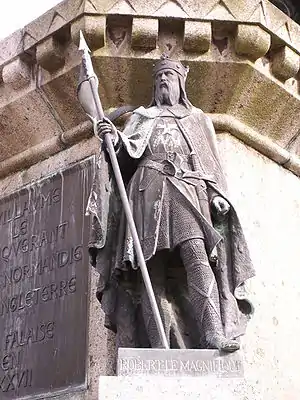1027
Year 1027 (MXXVII) was a common year starting on Sunday (link will display the full calendar) of the Julian calendar.
| Millennium: | 2nd millennium |
|---|---|
| Centuries: | |
| Decades: | |
| Years: |
| 1027 by topic |
|---|
| Leaders |
|
| Birth and death categories |
| Births – Deaths |
| Establishments and disestablishments categories |
| Establishments – Disestablishments |
| Gregorian calendar | 1027 MXXVII |
| Ab urbe condita | 1780 |
| Armenian calendar | 476 ԹՎ ՆՀԶ |
| Assyrian calendar | 5777 |
| Balinese saka calendar | 948–949 |
| Bengali calendar | 434 |
| Berber calendar | 1977 |
| English Regnal year | N/A |
| Buddhist calendar | 1571 |
| Burmese calendar | 389 |
| Byzantine calendar | 6535–6536 |
| Chinese calendar | 丙寅年 (Fire Tiger) 3723 or 3663 — to — 丁卯年 (Fire Rabbit) 3724 or 3664 |
| Coptic calendar | 743–744 |
| Discordian calendar | 2193 |
| Ethiopian calendar | 1019–1020 |
| Hebrew calendar | 4787–4788 |
| Hindu calendars | |
| - Vikram Samvat | 1083–1084 |
| - Shaka Samvat | 948–949 |
| - Kali Yuga | 4127–4128 |
| Holocene calendar | 11027 |
| Igbo calendar | 27–28 |
| Iranian calendar | 405–406 |
| Islamic calendar | 417–418 |
| Japanese calendar | Manju 4 (万寿4年) |
| Javanese calendar | 929–930 |
| Julian calendar | 1027 MXXVII |
| Korean calendar | 3360 |
| Minguo calendar | 885 before ROC 民前885年 |
| Nanakshahi calendar | −441 |
| Seleucid era | 1338/1339 AG |
| Thai solar calendar | 1569–1570 |
| Tibetan calendar | 阳火虎年 (male Fire-Tiger) 1153 or 772 or 0 — to — 阴火兔年 (female Fire-Rabbit) 1154 or 773 or 1 |

Robert the Magnificent (1000–1035)
Events
Europe
- March 26 – Pope John XIX crowns Conrad II ("the Elder") and his wife Gisela of Swabia as Holy Roman Emperor and Empress, respectively, in Old St. Peter's Basilica in Rome.[1] Cnut the Great, King of Denmark and England, attends the coronation, proving his position as sole ruler of the Danish North Sea Empire.
- May 14 – King Robert II of France ("the Pious") sues for peace with his sons. Henry I is crowned co-king of France at Reims Cathedral, but has little power to rule (until 1031).[2]
- August 6 – Robert the Magnificent becomes duke of Normandy after the death of his brother Richard III.
- Duke Sergius IV of Naples donates the County of Aversa to a band of Norman mercenaries led by Rainulf Drengot, who support him in the war with Capua.
- King Sigtrygg Silkbeard of Dublin and sub-King Flannacán of Brega make a pilgrimage to Rome.
- Ealdred is appointed abbot of Tavistock Abbey in England (approximate date).
Asia
- August 16 – Bagrat IV becomes king of Georgia on the death of his father, George I. Queen Dowager Mariam becomes regent for her 9-year-old son.
- Wedding of Crown Prince Atsunaga of Japan and Imperial Princess Teishi.
- This is the first year of the first rabjyung (60-year) cycle to start in the Tibetan calendar.
Science, technology and medicine
- The Book of Healing (Arabic: کتاب الشفاء Kitab Al-Shifaʾ, Latin: Sufficientia), a comprehensive scientific and philosophical encyclopedia written by the Persian polymath Avicenna (Abū ʿAlī ibn Sīnā), is published.[3]
- Song dynasty Chinese engineer Yan Su reinvents the 3rd-century south-pointing chariot, a mechanical-driven compass vehicle (as recorded in the Song Shi).
Births
- January 19 – Shōshi, Japanese empress consort (d. 1105)
- Albert III, count of Namur (House of Namur) (approximate date)
- Al-Mu'tamid ibn Abbad, Abbadid ruler of Seville (d. 1095)
- Ernest the Brave, margrave of Austria (d. 1075)
- Fayun Faxiu, Chinese Chan Buddhist monk (d. 1090)
- Matilda of Franconia, German princess (d. 1034)
- Sviatoslav II, Grand Prince of Kiev (d. 1077)
- Ulrich I (or Udalrich), German bishop (d. 1121)
Deaths
- January 3 – Fujiwara no Yukinari, Japanese calligrapher (b. 972)
- August 6 – Richard III, duke of Normandy (House of Normandy)
- August 16 – George I, king of Georgia (House of Bagrationi)
- October 16 – Fujiwara no Kenshi, Japanese dowager empress (b. 994)[4]
- Abu'l-Qasim al-Husayn ibn Ali al-Maghribi, Arab statesman (b. 981)
- Aurelia of Regensburg, daughter of Hugh Capet and saint
- Dayang Jingxuan, Chinese Zen Buddhist monk (b. 943)
- Dogra mac Dúnadach, king of Síol Anmchadha (Ireland)
- Gadhra Mór mac Dundach, king of Uí Maine (Ireland)
- Hippolytus, archbishop of Gniezno (approximate date)
- Walter of Speyer, German bishop and poet (b. 967)
- Yazid II, Persian ruler (shah) of Shirvan (Azerbaijan)
References
- Wolfram, Herwig (2006). Conrad II, 990-1039: Emperor of Three Kingdoms. Pennsylvania State University Press. p. 102. ISBN 0-271-02738-X.
- Clark, William W. (2006). Medieval Cathedrals. Westport, CT: Greenwood Publishing. p. 87. ISBN 978-0-313-32693-6.
- Goodman, Lenn Evan (1992). Avicenna. London: Routledge. p. 31. ISBN 0-415-01929-X.
- Izumi Shikibu writes a poem to her memory.
This article is issued from Wikipedia. The text is licensed under Creative Commons - Attribution - Sharealike. Additional terms may apply for the media files.